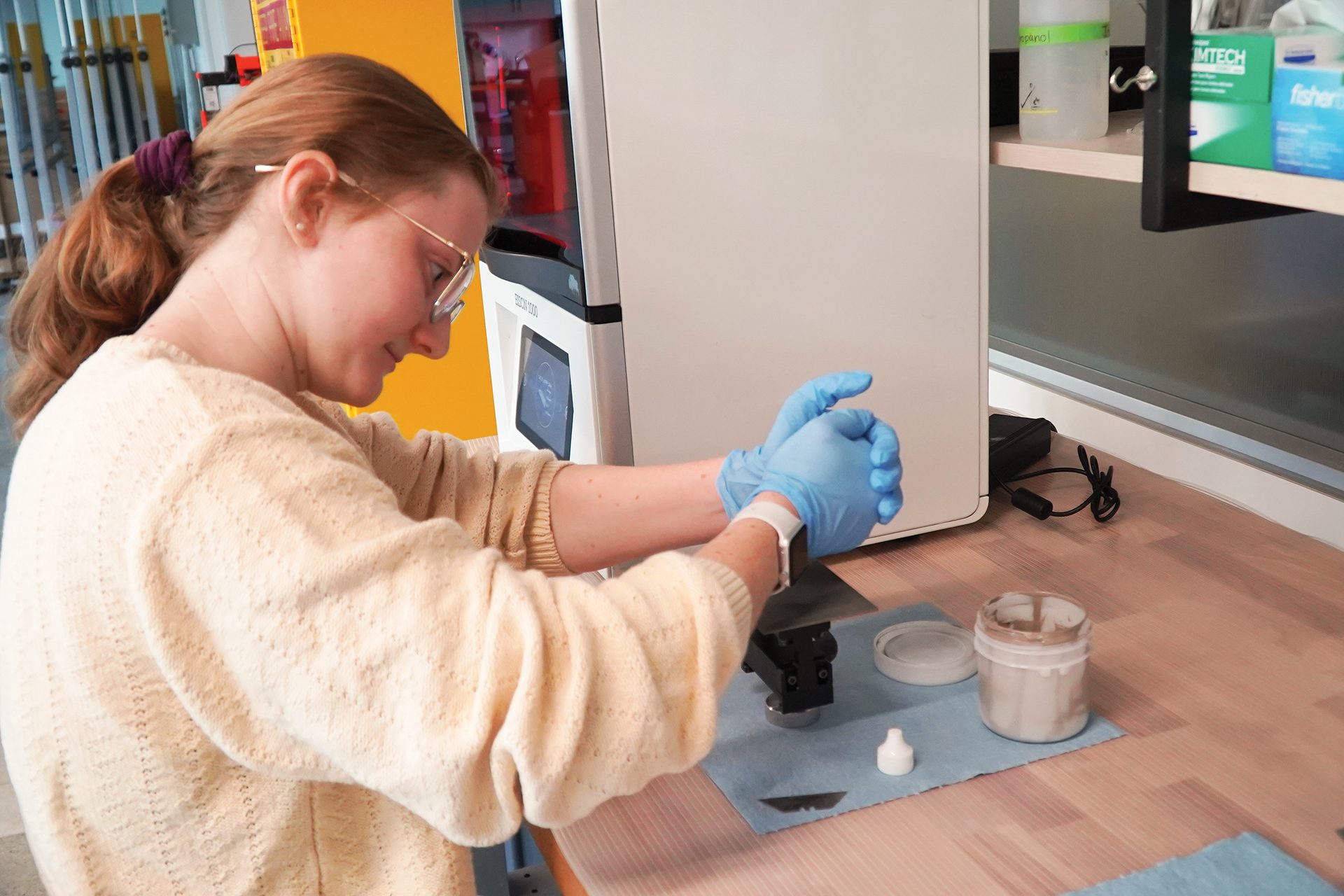
Engineering a sustainable future:
Summer Research Institute offers unique learning opportunities for Alfred University undergraduates
By Mark Whitehouse
bulletin | feature
In summer 2023, about 30 undergraduate engineering students at Alfred University in New York had the opportunity to participate in research settings normally reserved for graduate students thanks to the university’s new Summer Research Institute program.
The Summer Research Institute, held from May 30 through July 28, was developed to give students the opportunity to discover, very early in their college careers, how materials can impact everyday life. Normally, it is difficult to involve undergraduate students in a laboratory setting. But at Alfred University, where class sizes are smaller, there are more opportunities for students just beginning their educational journey to interact with faculty in a research environment.
“Alfred is one of a very few places in the country that has an emphasis on undergraduate research and hands-on experiences,” says Collin Wilkinson, professor of glass science. He supervised eight undergraduates in their summer research work.
The students who participated in this first Summer Research Institute came from a wide variety of engineering majors, including glass science engineering, ceramic engineering, biomaterials engineering, and materials science and engineering. Their research projects, which were supervised by 11 faculty members in the Inamori School of Engineering, addressed several important sustainability challenges.

Wilkinson

Wilkinson
In summer 2023, about 30 undergraduate engineering students at Alfred University in New York had the opportunity to participate in research settings normally reserved for graduate students thanks to the university’s new Summer Research Institute program.
The Summer Research Institute, held from May 30 through July 28, was developed to give students the opportunity to discover, very early in their college careers, how materials can impact everyday life. Normally, it is difficult to involve undergraduate students in a laboratory setting. But at Alfred University, where class sizes are smaller, there are more opportunities for students just beginning their educational journey to interact with faculty in a research environment.
Alfred is one of a very few places in the country that has an emphasis on undergraduate research and hands-on experiences,” says Collin Wilkinson, professor of glass science. He supervised eight undergraduates in their summer research work.
The students who participated in this first Summer Research Institute came from a wide variety of engineering majors, including glass science engineering, ceramic engineering, biomaterials engineering, and materials science and engineering. Their research projects, which were supervised by 11 faculty members in the Inamori School of Engineering, addressed several important sustainability challenges.

Wilkinson

Wilkinson
ADVERTISEMENT
Sustainability projects at the Summer Research Institute
Decreasing carbon emissions in glass manufacturing
Vasilii Maksimov from Moscow, Russia, is a junior majoring in glass science engineering and physics, with minors in computer science and mathematics. His project involved investigating ways to decrease the amount of environmentally harmful carbon dioxide produced during the production of glass.
“That’s a huge issue. We need to decarbonize the glass manufacturing process,” Maksimov says.
His research examined how melting glass with hydrogen combustion, which contains no greenhouse gases, affects the properties of glass, namely its durability and toughness.
“I’m simulating fractures in different types of glass and seeing how the concentration of hydrogen affects the toughness of the glass. It will contribute to a theoretical model that helps us understand hydrogen’s impact on the behavior of glass,” explains Maksimov, who is advised in his research by Wilkinson. “Theoretically, this could produce guidelines on whether to use hydrogen in the glass melting process.”
Recycling and reuse of glass waste products
Elene Taniashvili from Tbilisi, Georgia, is a sophomore majoring in glass science engineering. She conducted research aimed at developing fertilizer made from waste glass products (Figure 1).
“We’re trying to make a fertilizer that is more effective than traditional fertilizer and acts as a better silicon nutrient provider than rock dust,” she says.

Figure 1. Elene Taniashvili removes some melted glass from a furnace as part of her research on developing plant fertilizer using waste glass.
Credit: Alfred University
Taniashvili explained that glass contains some silicon-based materials that are beneficial to plant growth. Her research, advised by William LaCourse, emeritus professor of glass and current research faculty member, modifies glass waste from a powdered form into a foam material that can hold more water and come in contact with a greater soil surface area than powder. The foaming process is done using water glass—a compound containing sodium oxide and silica—which avoids carbon dioxide emissions.
A key to the development of an effective fertilizer made from waste glass is the removal of sodium, which is detrimental to plant growth. Taniashvili says removal can be achieved via a process called glass leaching, or ion exchange.
Alexander Johnsson from South Windsor, Connecticut, a junior majoring in ceramic engineering as well as art and design, is also working on the project. He explains that the ion exchange process uses water to remove sodium, which is high in alkalinity, and replaces it with potassium, which is good for plant growth.
Improving mechanical properties of UHTCs
Jane Heffernan from Eden, New York, is a sophomore majoring in ceramic engineering. Her project explored whether silicon carbide, an ultrahigh-temperature ceramic (UHTC), printed using digital light processing was stronger than silicon carbide created using a traditional extrusion-based 3D printing technique (Figure 2).
They are most concerned with the process and results to determine properties and how the materials hold up under extreme conditions, she says.
“3D printing based on photopolymerization is a much higher resolution. Using photopolymerization is still pretty new. We want to know how you can take it from the lab and use in industry,” she explains.
Her project is part of the master’s thesis project of graduate student Anthony Brandl, whom Heffernan is assisting. Brandl is advised by Junjun Ding, professor of materials science and engineering. The research is being conducted as part of a partnership with the U.S. Army Research Laboratory, in which Alfred University received a $13.5 million five-year contract to research the forming and characterization of UHTCs.

Figure 2. Jane Heffernan prepares a sample as part of her research studying ways to 3D print silicon carbide.
Credit: Alfred University
Glass for solid-state electrochemical electrolytes
Wyatt Kiff from Sidney, New York, is a senior majoring in glass science engineering. His research, which is part of his senior thesis project, involved creating atomistic simulations to computationally analyze glass physics for applications in solid-state electrochemical electrolytes. Kiff, with Wilkinson as his advisor, worked on the project during his junior year and continued his research during the Summer Research Institute.
Recycling photovoltaic components
Beatrice Crespo from Tacoma Park, Maryland, is a sophomore majoring in glass science engineering as well as art and design. She researched the feasibility of recycling photovoltaic components in solar panels from both a technical and economic standpoint.
The recycling process, Crespo explains, involves delamination of the solar panels, which is required before the panels can be reused. Her project, under the advisement of Wilkinson and Gabrielle Gaustad, dean of the Inamori School of Engineering, investigated both thermal delamination—which uses heat to soften and remove the laminate—and chemical solvent delamination.
Ensuring a sustainable learning environment for students
The Summer Research Institute program provided more than just research opportunities—numerous professional development and socializing events took place as well.
“Research is difficult. You can’t just put the student in the lab and say ‘Go.’ It’s not sustainable; you have to have social activities,” says Wilkinson, who hosted a group of undergraduates at his home to celebrate the Fourth of July.
Examples of non-research activities during the Summer Research Institute include field trips to plants and facilities, such as Guardian Glass and Owens-Illinois; a tour of the Corning Museum of Glass; and presentations given by faculty and administrators. Gaustad spoke about giving public talks while Scott Misture, Inamori Professor of Materials Science and Engineering, talked about the value of international travel and study abroad programs. The program culminated with a poster contest, where students presented their various research projects.
Feedback from the students confirmed the effectiveness of the Summer Research Institute.
“By summer’s end, I will have written a paper, participated in a poster contest, and completed a research project, all before my sophomore year starts. That usually takes an entire undergraduate career,” says Crespo, who studied the recycling of photovoltaic components. “This definitely gives me a leg up. I can’t imagine a better experience to put me in a position to continue succeeding.”
Gaustad hopes to see the program grow in future years to provide even more students the opportunity to pursue their research interests.
“The fields of ceramics, glass, and materials science are constantly changing how we interact with the world around us,” she says. “It’s my expectation that we’ll see more students involved in this summer program in future years, pursuing research in topics that are not only important to them but to society as a whole.”
This first Summer Research Institute was sponsored by the Center for Advanced Ceramic Technology (CACT) at Alfred University; the New York State Foundation for Science, Technology, and Innovation; Corning Inc.; Owens-Corning; and Washington Mills.
The Summer Research Institute will be offered again in summer 2024. It is open to all students at both Alfred and other institutions.
About the author:
Mark Whitehouse is director of communications at Alfred University. Contact Whitehouse.
